Home / SN1 vs E1 and SN2 vs E2 : The Temperature
SN1/SN2/E1/E2 Decision
SN1 vs E1 and SN2 vs E2 : The Temperature
Last updated: June 24th, 2025 |
SN1 vs E1, and SN2 vs. E2: The Role Of Heat
- This article assumes you understand the mechanisms of the SN1/SN2/E1 and E2 reactions. For review, see here [SN1] [SN2] [E1] [E2]
- SN1/SN2/E1/E2 reactions tend to happen on alkyl halides [see Identifying Where Substitution and Elimination Reactions Happen]
- Determining whether the alkyl halide is primary, secondary, tertiary (or methyl) helps to narrow down the possibilities [See SN1/SN2/E1/E2 – The Substrate]
- When the nucleophile/base is negatively charged, the reaction tends to be SN2/E2. When the nucleophile/base is neutral, the reaction tends to be SN1/E1. [See SN1/SN2/E1/E2 – The Nucleophile/Base ]
- If the major reaction pathway cannot be determined by examining these factors, the next useful indicator is to look at the temperature.
- Generally, if you are trying to decide between SN1 and E1 (e.g. for a tertiary alkyl halide with a neutral nucleophile/base), heat (Δ ) indicates E1, whereas the absence of heat indicates SN1
- If you are trying to decide between SN2 and E2 (e.g. for a secondary alkyl halide with a strong base, e.g. HO(-) or RO(-) ) , heat (Δ ) indicates E2. (The absence of heat does not necessarily indicate SN2 – check with your instructor).
- Heat may also be indicated in difficult SN1 reactions (e.g. secondary alkyl halide, neutral nucleophile/base) where rearrangements occur.
I also suggest, ahem, pinning down your instructor beforehand on some of these questions because these questions can be subject to a lot of variation.
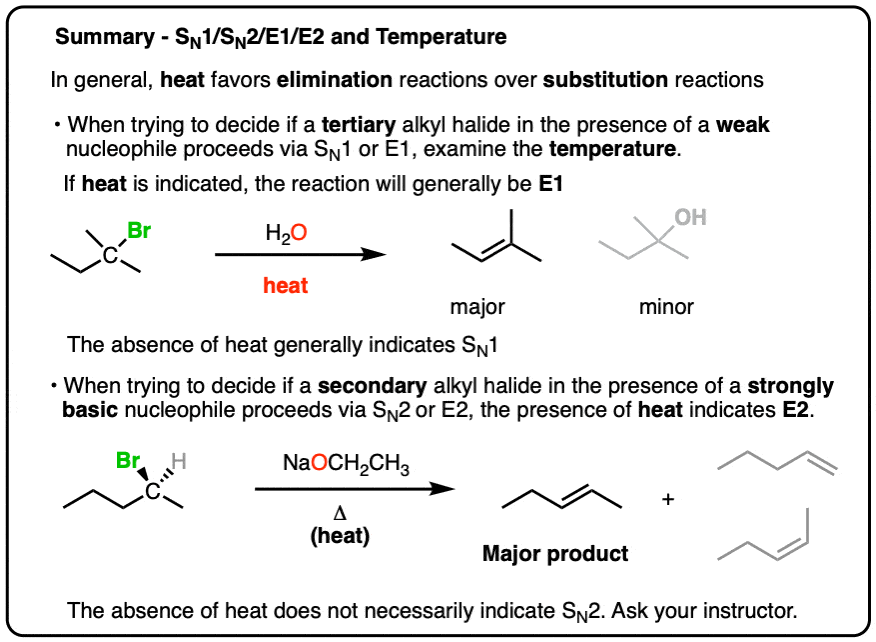
Table of Contents
1. The Role of “Heat” (Δ) In Substitution and Elimination Reactions
Previously we’ve outlined the main steps in deciding whether a reaction goes through SN1/SN2/E1/E2. (Note – it’s assumed by this point that if you know the mechanism of the reaction, you should be able to correctly draw the product!)
These steps are, roughly:
- Identify an sp3 hybridized (alkyl) carbon…
- with a good leaving group…
- classify the carbon as primary, secondary or tertiary…
- identify the strongest nucleophile/base in the reaction (for our purposes, I will often refer to negatively charged species as “strong” and neutral species as “weak“, although there are some exceptions – see article).
If you’ve gone through all these steps and applied the key rules, there are only a handful of possible dilemmas you might be facing based on what we’ve covered so far.
Those dilemmas are:
- A tertiary carbon with a weak nucleophile/base: SN1 vs E1
- A secondary carbon with strongly basic nucleophile like RO(-) or HO(-): E2 vs SN2
- A primary alkyl halide with a strong, bulky base like t-butoxide (t-BuO– ).
Once you’ve looked at those factors, the next factor to evaluate is the temperature.
- The key point of this article is that if heat is indicated, it’s almost certainly elimination, not substitution, because heat favors elimination reactions. [See post: Elimination Reactions Are Favored By Heat]
2. Evaluating SN1 vs E1 : The Role of Heat
Alright. Let’s dig into our first case.
Say we have a tertiary alkyl halide with a weak (neutral) base
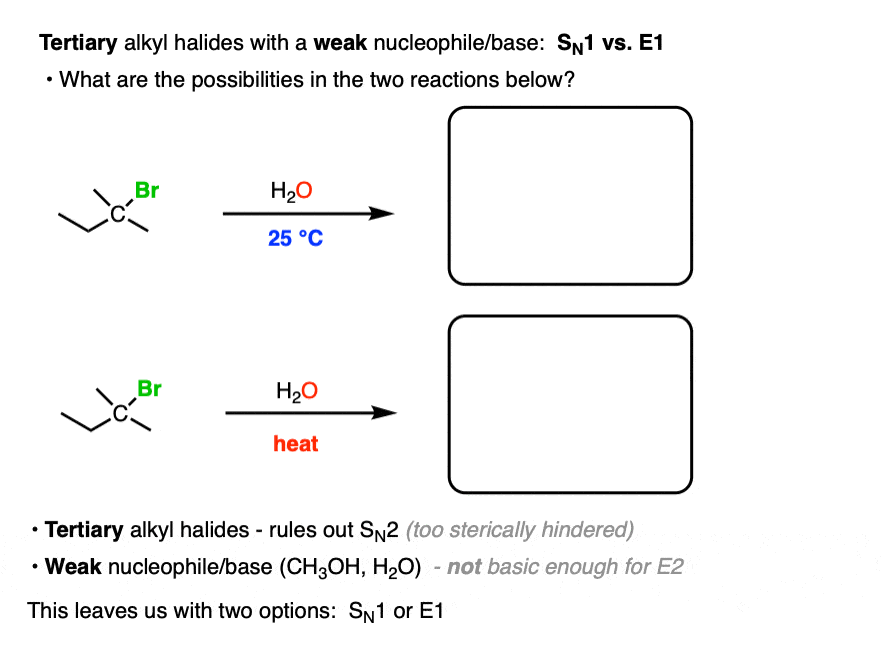
- You should already have ruled out SN2, due to steric hindrance [See article: The SN2 mechanism]
- We have a weak base, which generally rules out E2.
That leaves us with two solid possibilities. SN1 or E1.
In practice, these reactions generally give a mixture of substitution (SN1) and elimination (E1) products.
That being said:
- Lower temperatures (e.g. room temperature, 25 °C) tend to provide mostly SN1 products.
- Higher temperatures (“heat”) tend to provide mostly E1 products.
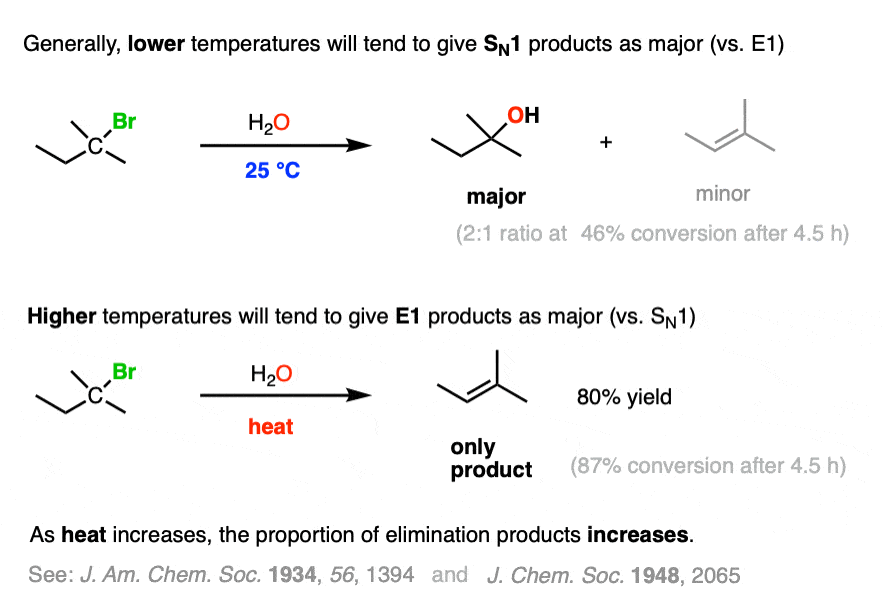
In the lab, there is lots of variation, but invariably, higher temperatures result in more elimination. For some real-life results, see Note 1. (See article: Elimination Reactions Are Favored By Heat)
Let’s look at some representative quizzes:
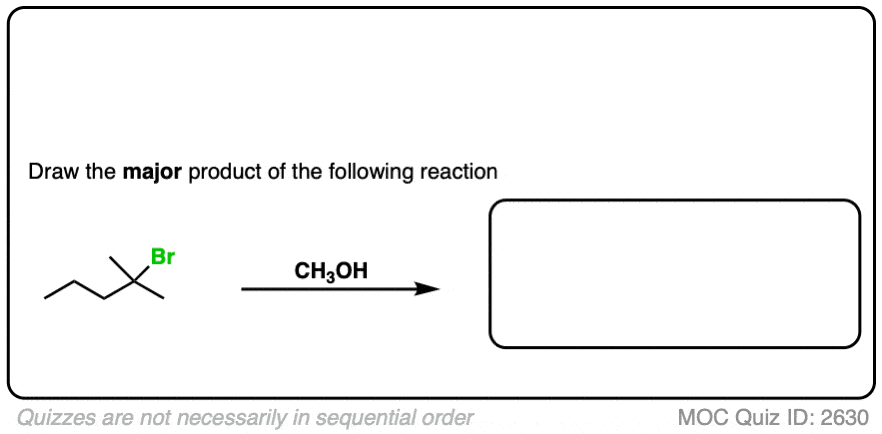 Click to Flip
Click to Flip
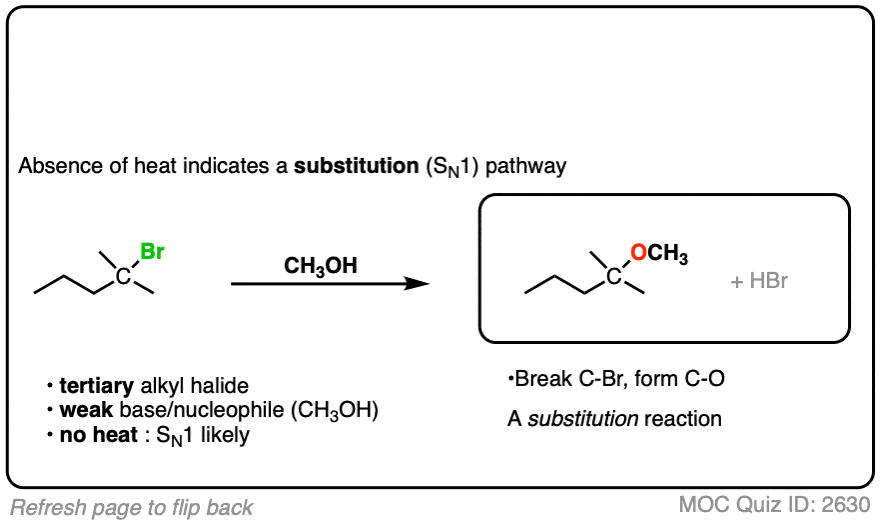
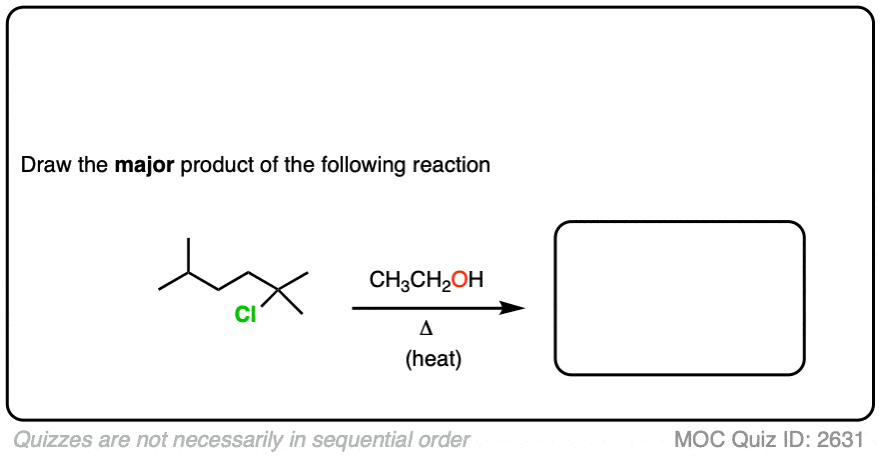 Click to Flip
Click to Flip
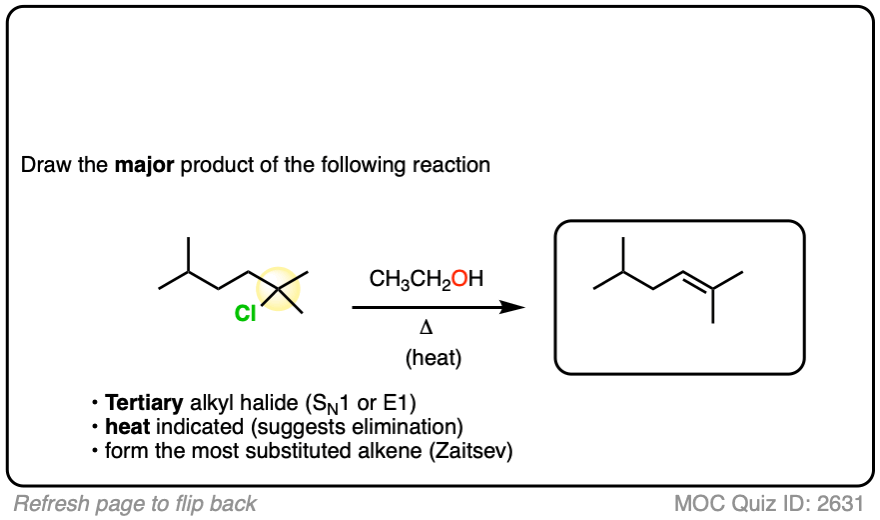
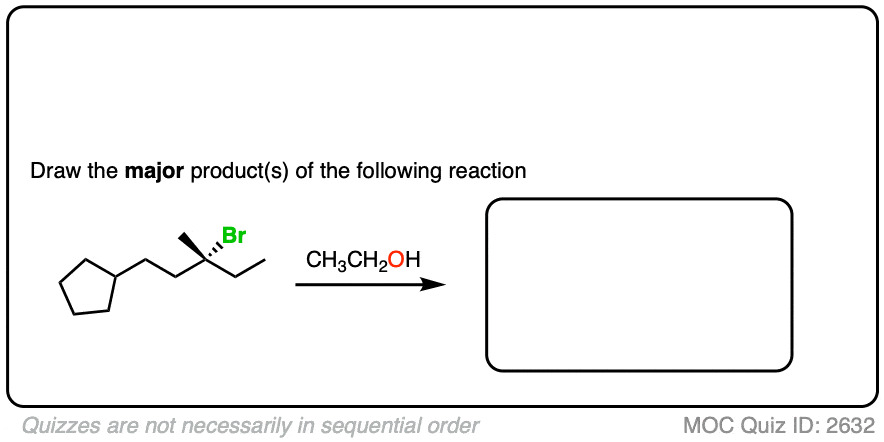 Click to Flip
Click to Flip

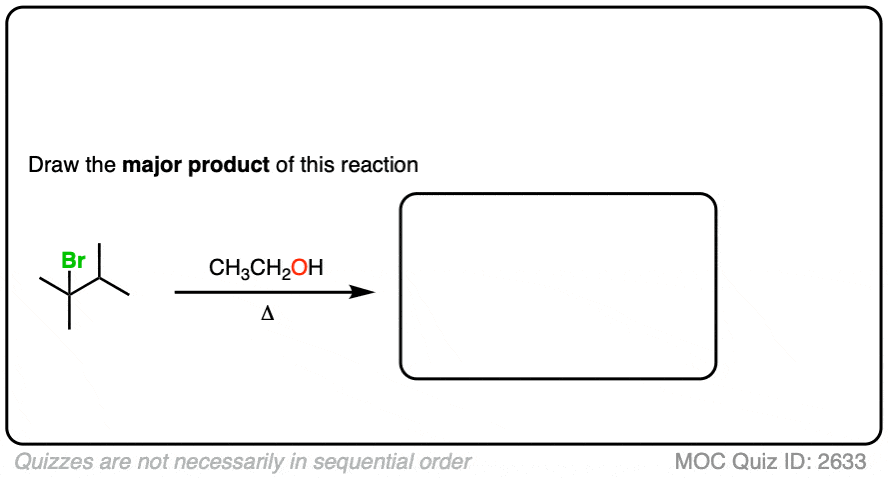 Click to Flip
Click to Flip
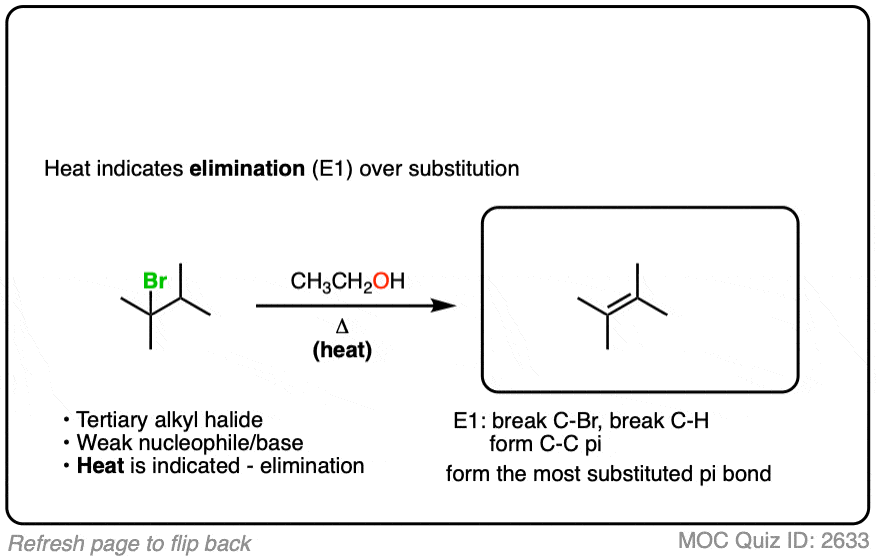
3. SN2 vs E2 – Secondary Alkyl Halides
Another dilemma faces us when we encounter a secondary alkyl halide with a strong base such as an alkoxide (e.g. sodium methoxide, NaOCH3 or potassium ethoxide, KOCH2CH3 ) or hydroxide (HO– ) ion.
- The charged nucleophile/base generally rules out E1 and SN1
- An alkoxide (conjugate base of an alcohol, pKa 16-18) is strong enough to perform elimination through the E2 pathway.
- However, a secondary carbon is not sterically hindered enough to completely rule out SN2
So our choices at this point are either E2 or SN2 :
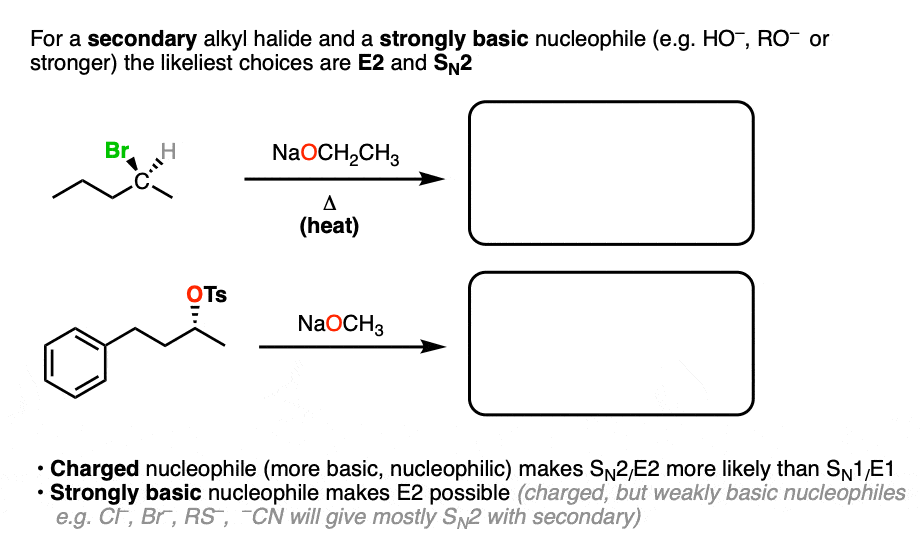
- If heat is applied, then the major product is almost certainly E2 since elimination reactions are favored by heat.
- Absence of heat it does not necessarily imply SN2. But it might. Ask your instructor, because answers vary.
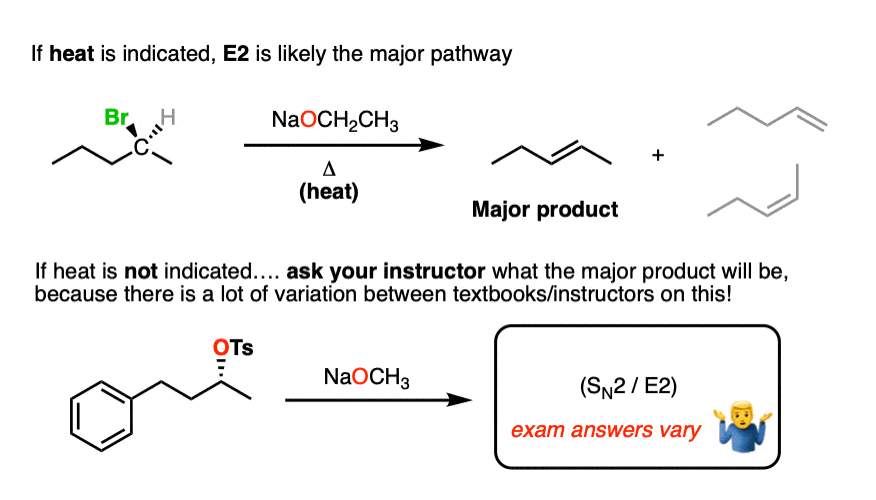
For some laboratory results with secondary alkyl halides and strongly basic nucleophiles, see [Note 2 ]
Here are some relevant quizzes:
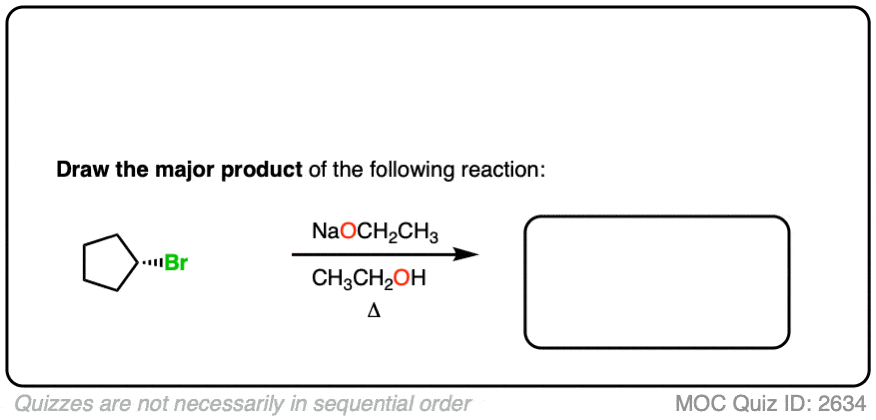 Click to Flip
Click to Flip
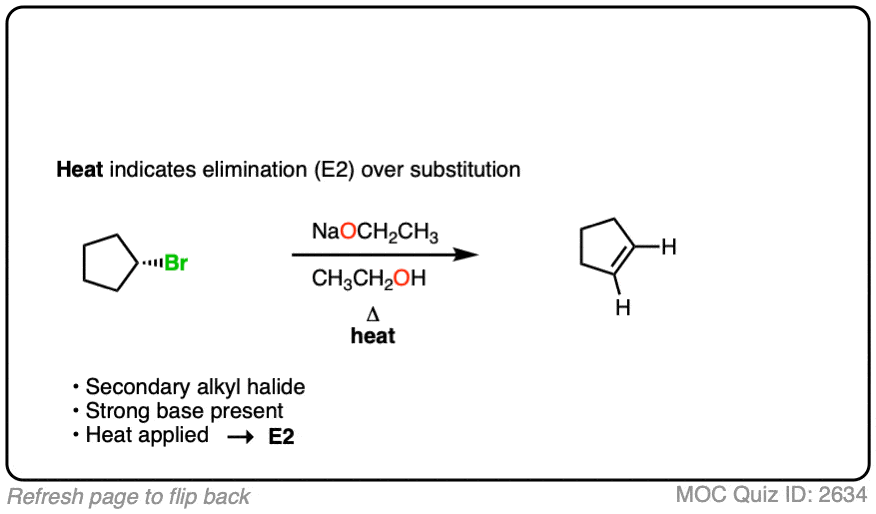
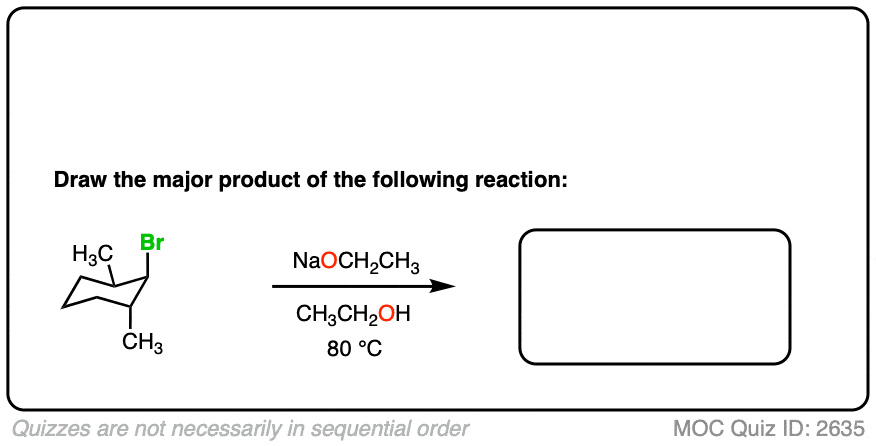 Click to Flip
Click to Flip
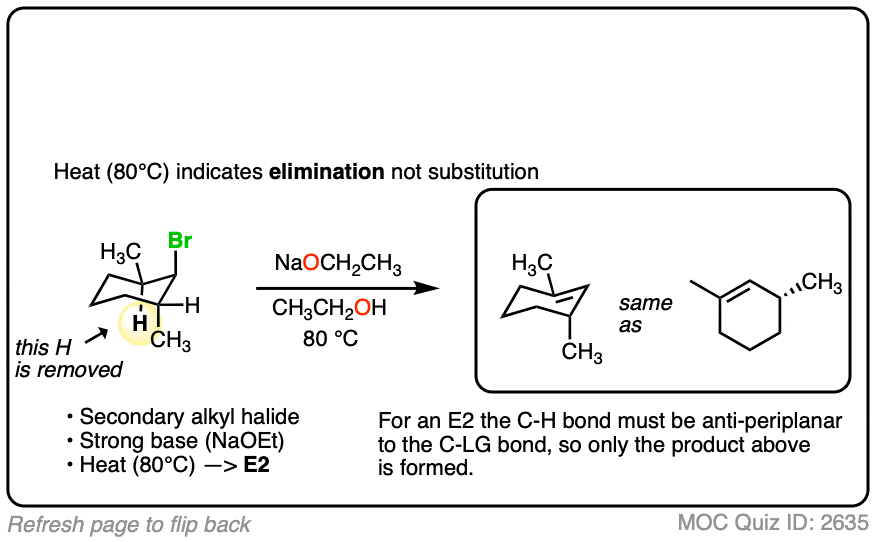
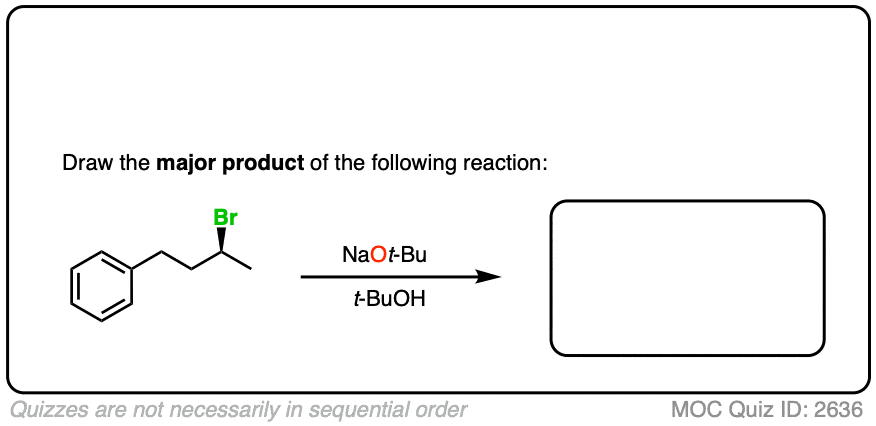 Click to Flip
Click to Flip
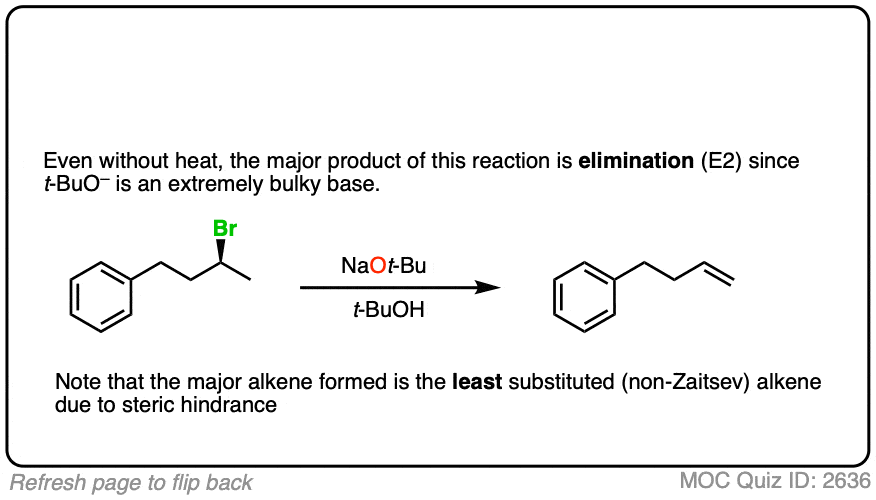
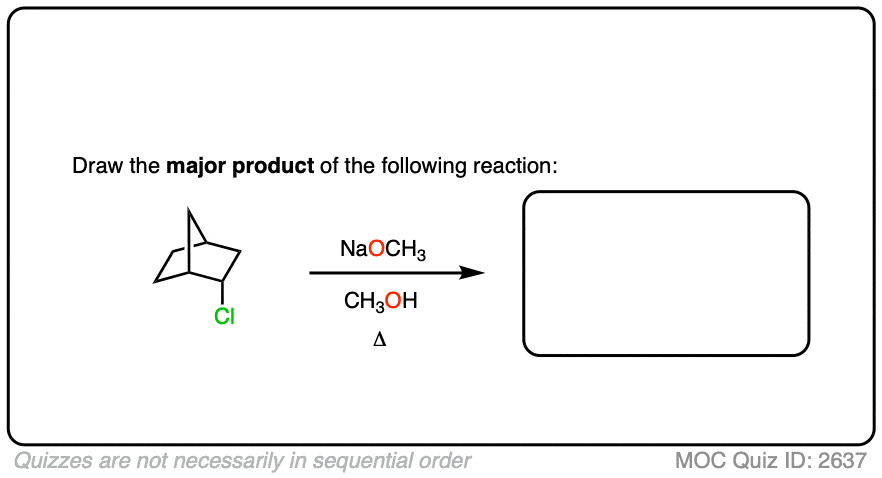 Click to Flip
Click to Flip
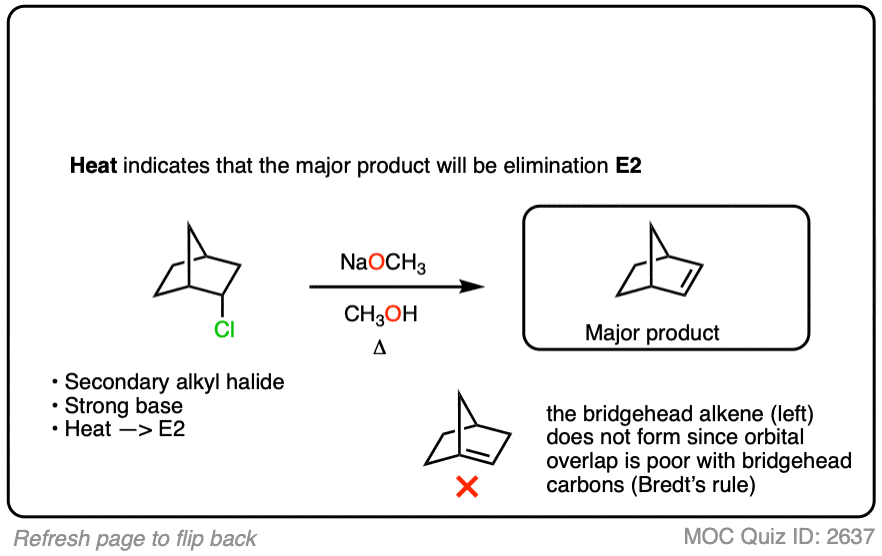
4. SN2 vs E2 – Primary Alkyl Halides
Another SN2 vs E2 dilemma is presented by a primary alkyl halide with a bulky strong base like KOt-Bu in the presence of heat.
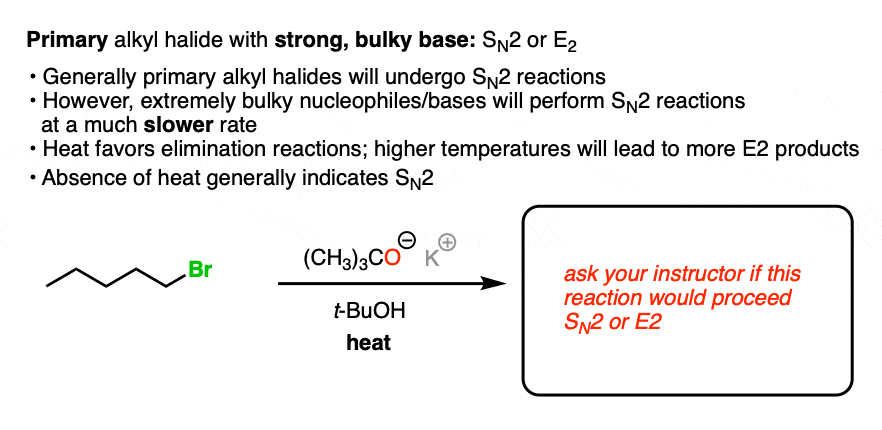
- It can’t be SN1/E1 (primary)
- It is likely SN2 but the bulky base and heat means that E2 is also a possibility
This is another situation where there is variation between different instructors. I’d suggest asking for clarity from your instructor on this specific question, because answers can vary.
Also be on the lookout for additional factors that may tip the scales away from SN2. For example, the presence of another alkyl group on the carbon adjacent to the primary alkyl halide will increase steric hindrance on the primary alkyl halide. Since the rate of the SN2 reaction is very sensitive to steric hindrance, this will make elimination more likely, relative to substitution.
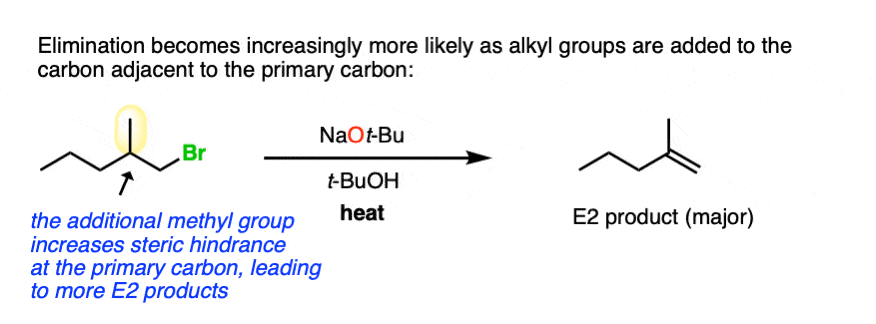
In the absence of heat, reactions of primary alkyl halides with t-butoxide ions will generally be SN2.
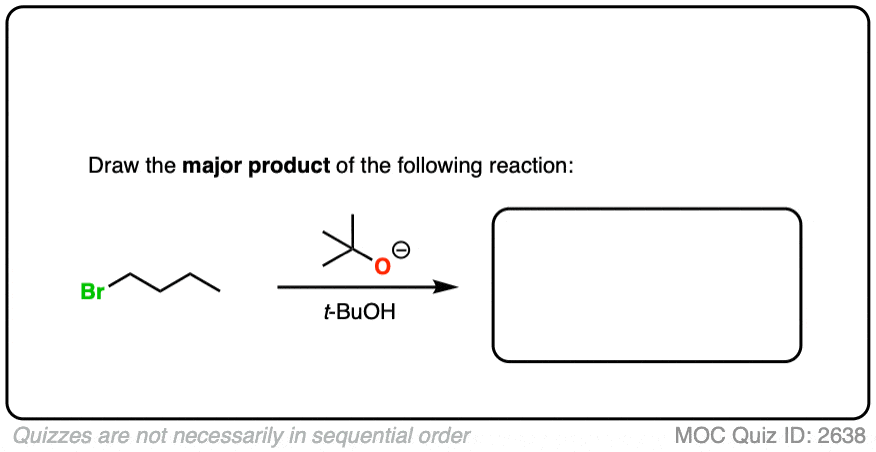 Click to Flip
Click to Flip
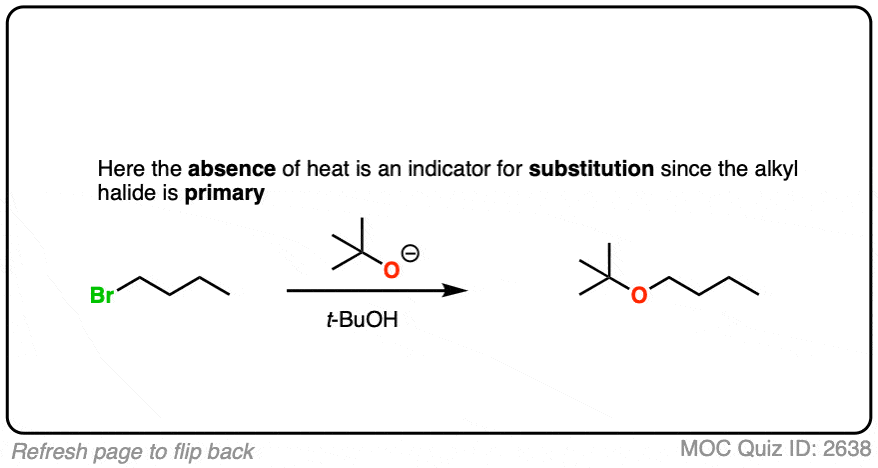
5. Heat and the SN1: Watch Out For Rearrangements
Although up to this point I’ve been suggesting a near-Pavlovian relationship between seing “heat” and thinking “elimination”, it’s worth putting up a final set of examples where heat is less likely to result in elimination.
Secondary alkyl halides can participate in substitution reactions via the SN1 pathway, but these reactions are generally quite slow. To happen at any kind of a practical rate, they generally require a kick in the pants in the form of added heat.
Secondary alkyl halides in the presence of poor nucleophiles (like H2O and alcohols) also provide an opportunity for your instructor to test you on rearrangement reactions such as hydride shifts and alkyl shifts. (See article: Rearrangement reactions with hydride shifts)
So in these cases (i.e. secondary alkyl halide with poor nucleophile/base) it’s advisable look at the added “heat” as making rearrangement more likely, rather than elimination.
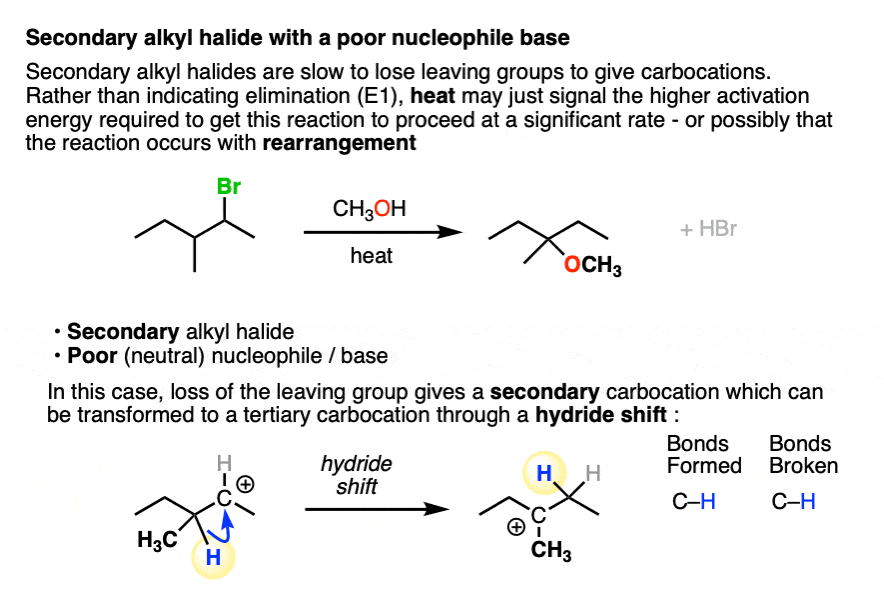
For some results from the lab regarding SN1 vs E1 on secondary alkyl halides, see Note 3.
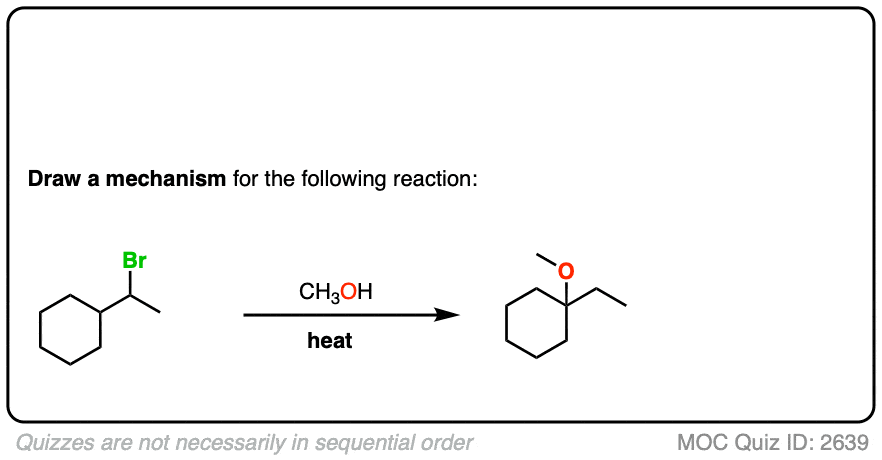 Click to Flip
Click to Flip
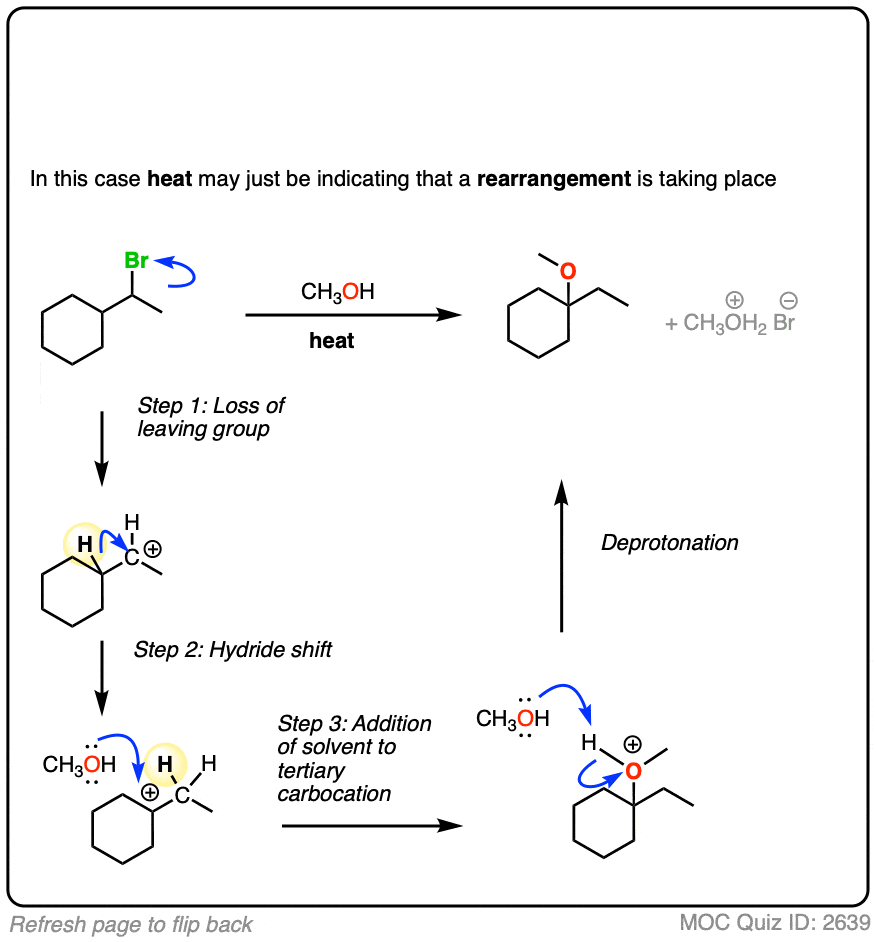
6. Summary
In case the point hasn’t been hammered home enough: if you see “heat”, think elimination.
At the very least, the clear trend is that as temperature is increased, the elimination: substitution ratio will increase.
For exam-preparation purposes, one possible exception to “heat = elimination” is the case of secondary alkyl halides in the presence of poor nucleophiles such as alcohols or H2O. In this case, heat provides the activation energy necessary for the leaving group to leave, forming a secondary carbocation (which may then undergo a subsequent elimination reaction, depending on structure).
In the next article, we’ll cover the last important variable in SN1/SN2/E1/E2 – the solvent. [See article: Deciding SN1/SN2/E1/E1 – The Solvent)
Notes
Related Articles
- Deciding SN1/SN2/E1/E2 (3) – The Solvent
- Identifying Where Substitution and Elimination Reactions Happen
- The SN1 Mechanism
- The E1 Reaction
- Comparing the E1 vs SN1 Reactions
- Elimination Reactions Are Favored By Heat
- Deciding SN1/SN2/E1/E2 (1) – The Substrate
- Deciding SN1/SN2/E1/E2 (2) – The Nucleophile/Base
- SN1 SN2 E1 E2 Practice Problems (MOC Membership)
- Rearrangement Reactions (1) – Hydride Shifts
Note 1. The trend of increasing heat resulting in increased elimination products is clear. However it isn’t always as dramatic as it is in the first example.
Here are some examples from an early paper (J. Chem. Soc. 1948, p. 2049) that show a more modest relationship between temperature and heat.
First example is with t-butyl chloride with ethanol and water as solvent:
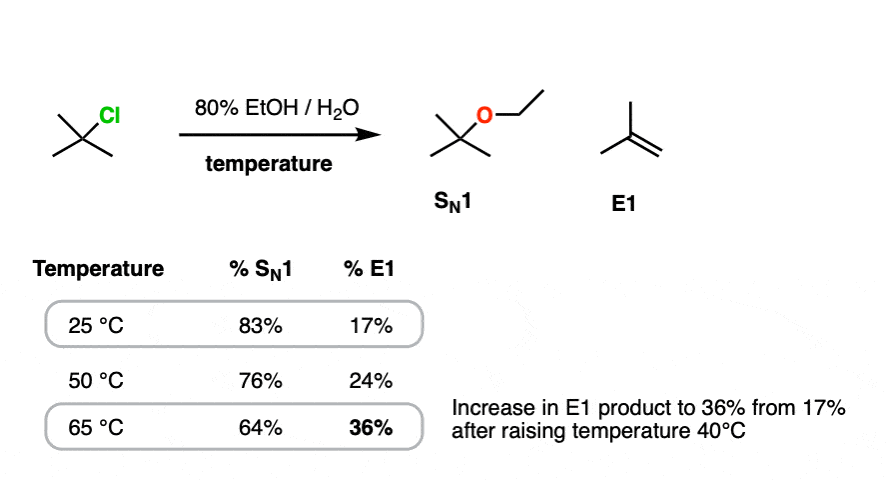
In the real world, adding heat is not like flipping a switch that suddenly changes the reaction from one major product to another. Going from 17% elimination at room temperature to 36% elimination at 65°C is a pretty modest change.
This is why SN1/E1 reactions don’t tend to get used that much in modern organic chemistry – we get mixtures, and mixtures take time to separate. A better use of our time is employing reactions that will give one dominant product (the E2 would be better for making the alkene here, for instance).
In the same article the authors ran a similar reaction with t-butyl bromide in 100% ethanol as solvent and varied the heat. The ratio of SN1: E1 went from 81:19 at 25°C to 72:28 at 55°C. Hover here to see this example or click this link.
Another reaction reported in the same paper was 2-chloro-2-methylbutane in 80% ethanol/water. At 25°C the SN1:E1 ratio was 67:33, which changed to 60:40 at 50°C. Hover here to see this example or click this link.
Note 2. Despite how important it might seem from the perspective of someone learning organic chemistry for the first time, there actually aren’t a huge number of examples of SN2 reactions actually working well between strong bases and secondary alkyl halides.
Maybe the best example is between isopropyl bromide (a.k.a. 2-bromopropane) and sodium ethoxide. In this case, the SN2 product is produced in 42% yield. This might seem OK at first, until we note that the major product is E2. With heating, the SN2:E2 ratio decreases even more.
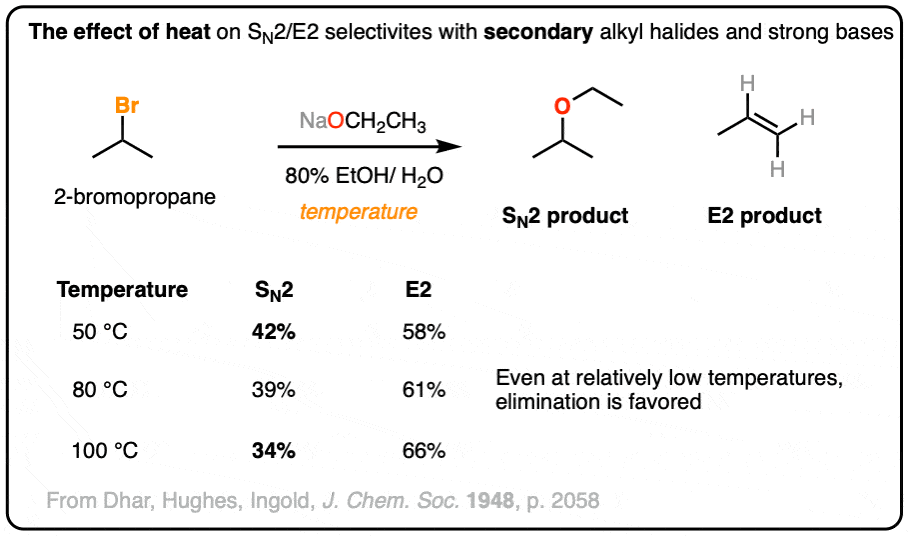
Things get even worse for SN2 once an extra alkyl group is added adjacent to the secondary carbon. For isobutyl bromide reacting with NaOEt in ethanol, the SN2:E2 ratio is 18:82 at 25°C and 9:91 at 80°C.
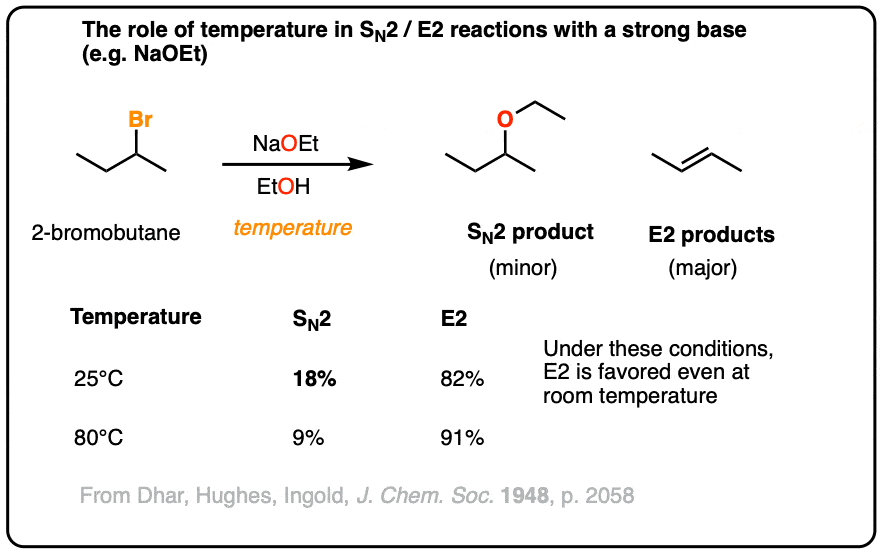
We’ll have more to say about the SN2 reaction of secondary alkyl halides with strongly basic nucleophiles in the next article, when we consider solvent.
Note 3. What about secondary alkyl halides with a poor nucleophile/base? What happens whcn this reaction mixture is heated? Does E1 dominate?
No. One study [Ref] heated a series of secondary alkyl halides in ethanol at 80°C. The resulting products were mostly substitution, with a small amount of elimination (5-15% depending on structure – the more hindered the secondary alkyl halide, the more elimination took place).
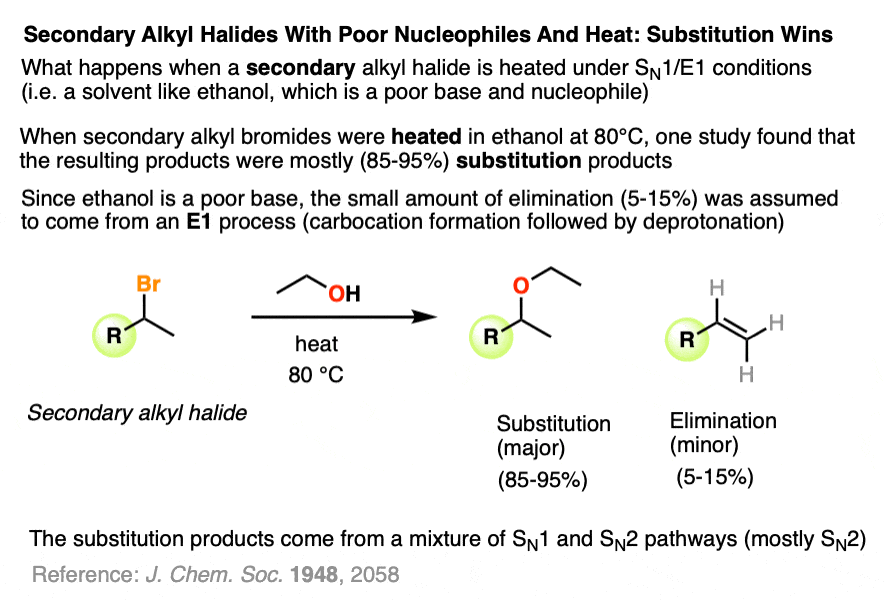
Since ethanol is a weak base and not really capable of deprotonation through E2, it was proposed that elimination mostly occurred through an E1 pathway (i.e. carbocation formation, followed by deprotonation to give the alkene).
The substitution products can arise through both SN2 (direct attack by the solvent) or SN1 (loss of the leaving group followed by attack of solvent).
At least in the simple cases studied, the major pathway is SN2.
(Another unpublished study subjected optically active 2-octyl tosylate to heating in ethanol and found the resulting ether (2-ethoxyoctane) to have 81% inversion of configuration. So SN2 really does seem to be dominant, at least in fairly simple cases.)
Quiz Yourself!
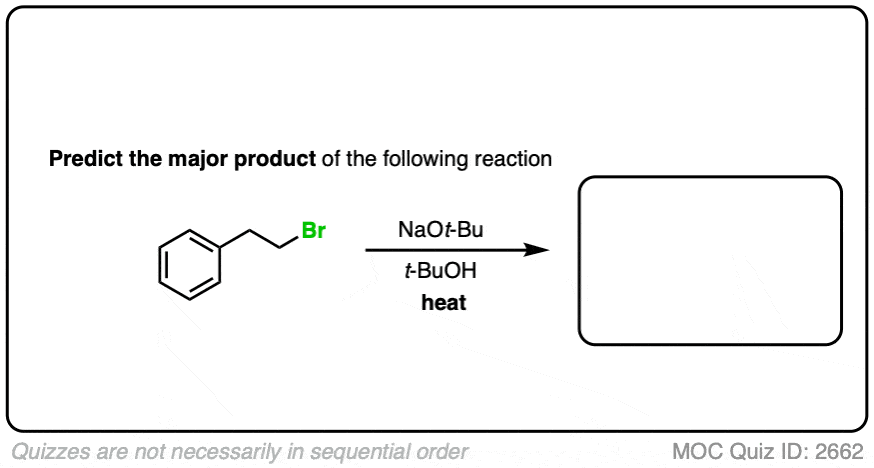 Click to Flip
Click to Flip
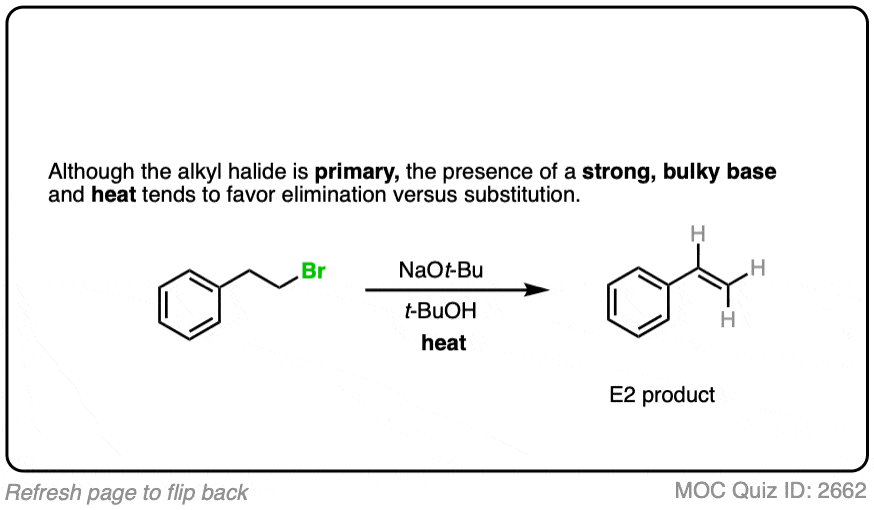
(Advanced) References and Further Reading
A general, but quite technical, overview of the SN1/SN2/E1/E2 landscape is given in Solvolytic Displacement Reactions by Andrew Streitweiser. It is a useful review of the fragmented early literature on SN1/SN2/E1/E2 that includes many tables still found in organic chemistry textbooks today.
Prof. Streitweiser also wrote a popular textbook for introductory organic chemistry in 1976, “Introduction To Organic Chemistry“, that went through multiple editions. The section on substitution reactions contains tables of relative rates and yields of various reactions that are also found in his earlier review.
I’m not sure if it’s completely fair to lay the current emphasis on SN1/SN2/E1/E2 reactions in introductory texts at the feet of Prof. Streitweiser, but there is no question his textbook has had a strong influence on it.
- 421. Mechanism of elimination reactions. Part XI. Kinetics of olefin elimination from tert.-butyl and tert.-amyl bromides in acidic and alkalinc alcoholic media
M. L. Dhar, E. D. Hughes, C. K. Ingold
J. Chem. Soc., 1948, 2065
DOI: 10.1039/JR9480002065
Among other things, this is a study of SN1 vs E1 at room temperature (25°C). At 25°C in ethanol, t-butyl bromide gives 81% substitution (SN1) and 19% elimination (E1) cor. t-amyl bromide (2-bromo-2-methylbutane) gives 64% SN1 and 36% E1. The rate constants for each of these reactions are also measured (Table VI). - 418. Mechanism of elimination reactions. Part VIII. Temperature effects on rates and product-proportions in uni- and bi-molecular substitution and elimination reactions of alkyl halides and sulphonium salts in hydroxylic solvents
K. A. Cooper, E. D. Hughes, C. K. Ingold, B. J. MacNulty
J. Chem. Soc., 1948, 2049-2054
DOI: 10.1039/JR9480002049
Study of the effect of increasing temperature on SN1 vs. E1 and SN2 vs. E2. In each case it is found that heat increases the proportion of elimination products. For SN2 and E2 they have this to say:
“For any given pair of simultaneous bimolecular processes, the elimination has, in each of the investigated cases, an Arrhenius energy of activation which lies higher than that of the accompanying substitution by 1-2 kcals/mol. The elimination thus has always the larger temperature coefficient, so that a rise of temperature increases the proportions in which olefin is formed.” For SN2 vs. E2 they measure the pre-exponential constant for the Arrhenius equation as well as the energies of activation. The pre-exponential constants for the elimination reactions are higher in each case.
For SN1 vs E1, the rate determining step is identical for both (loss of the leaving group). - 420. Mechanism of elimination reactions. Part X. Kinetics of olefin elimination from isopropyl, sec.-butyl, 2-n-amyl, and 3-n-amyl bromides in acidic and alkaline alcoholic media
M. L. Dhar, E. D. Hughes, C. K. Ingold
J. Chem. Soc. 1948. 2058-2065
DOI: 10.1039/JR9480002058
Intereresting result from this study is the relationship between heat and substitution/elimination products. Table I in this paper shows that solvolysis of 2-bromobutane with 1 M NaOEt in ethanol gives 82% yield of alkene at 25 °C, but similar solvolysis at 80 °C gives 91.4% yield of alkene. - Steric Effects in Elimination Reactions. IX. The Effect of the Steric Requirements of the Leaving Group on the Direction of Bimolecular Elimination in 2-Pentyl Derivatives
Herbert C. Brown and Owen H. Wheeler
Journal of the American Chemical Society 1956, 78 (10), 2199-2202
DOI: 1021/ja01591a049
Classic study on the proportion of alkenes formed through elimination of 2-bromopentane (and similar substrates) with t-butoxide bases. The major product is always the least substituted alkene (non-Zaitsev alkene). - The Hydrolysis of Tertiary Aliphatic Halides – I
H. Milton Woodburn and F. C. Whitmore
J. Am. Chem. Soc. 1934, 56, 1394
DOI: 10.1021/ja01321a055
Hard to find clear literature examples where heat = E1 and no heat = SN1, but this set from 1934 on the reaction of t-amyl halides is fairly straightforward. Conducting the hydrolysis of t-amyl bromide in the cold gives about 2:1 alcohol : alkene, whereas performing the same reaction under reflux gives exclusively elimination. Would like to see this reproduced under more modern conditions and quantified more thoroughly. Note that slight variations in structure (e.g. swapping t-Bu for t-Am, swapping Cl for Br, changing solvents) also has a significant effect on yields/ratios.
00 General Chemistry Review
01 Bonding, Structure, and Resonance
- How Do We Know Methane (CH4) Is Tetrahedral?
- Hybrid Orbitals and Hybridization
- How To Determine Hybridization: A Shortcut
- Orbital Hybridization And Bond Strengths
- Sigma bonds come in six varieties: Pi bonds come in one
- A Key Skill: How to Calculate Formal Charge
- The Four Intermolecular Forces and How They Affect Boiling Points
- 3 Trends That Affect Boiling Points
- How To Use Electronegativity To Determine Electron Density (and why NOT to trust formal charge)
- Introduction to Resonance
- How To Use Curved Arrows To Interchange Resonance Forms
- Evaluating Resonance Forms (1) - The Rule of Least Charges
- How To Find The Best Resonance Structure By Applying Electronegativity
- Evaluating Resonance Structures With Negative Charges
- Evaluating Resonance Structures With Positive Charge
- Exploring Resonance: Pi-Donation
- Exploring Resonance: Pi-acceptors
- In Summary: Evaluating Resonance Structures
- Drawing Resonance Structures: 3 Common Mistakes To Avoid
- How to apply electronegativity and resonance to understand reactivity
- Bond Hybridization Practice
- Structure and Bonding Practice Quizzes
- Resonance Structures Practice
02 Acid Base Reactions
- Introduction to Acid-Base Reactions
- Acid Base Reactions In Organic Chemistry
- The Stronger The Acid, The Weaker The Conjugate Base
- Walkthrough of Acid-Base Reactions (3) - Acidity Trends
- Five Key Factors That Influence Acidity
- Acid-Base Reactions: Introducing Ka and pKa
- How to Use a pKa Table
- The pKa Table Is Your Friend
- A Handy Rule of Thumb for Acid-Base Reactions
- Acid Base Reactions Are Fast
- pKa Values Span 60 Orders Of Magnitude
- How Protonation and Deprotonation Affect Reactivity
- Acid Base Practice Problems
03 Alkanes and Nomenclature
- Meet the (Most Important) Functional Groups
- Condensed Formulas: Deciphering What the Brackets Mean
- Hidden Hydrogens, Hidden Lone Pairs, Hidden Counterions
- Don't Be Futyl, Learn The Butyls
- Primary, Secondary, Tertiary, Quaternary In Organic Chemistry
- Branching, and Its Affect On Melting and Boiling Points
- The Many, Many Ways of Drawing Butane
- Wedge And Dash Convention For Tetrahedral Carbon
- Common Mistakes in Organic Chemistry: Pentavalent Carbon
- Table of Functional Group Priorities for Nomenclature
- Summary Sheet - Alkane Nomenclature
- Organic Chemistry IUPAC Nomenclature Demystified With A Simple Puzzle Piece Approach
- Boiling Point Quizzes
- Organic Chemistry Nomenclature Quizzes
04 Conformations and Cycloalkanes
- Staggered vs Eclipsed Conformations of Ethane
- Conformational Isomers of Propane
- Newman Projection of Butane (and Gauche Conformation)
- Introduction to Cycloalkanes
- Geometric Isomers In Small Rings: Cis And Trans Cycloalkanes
- Calculation of Ring Strain In Cycloalkanes
- Cycloalkanes - Ring Strain In Cyclopropane And Cyclobutane
- Cyclohexane Conformations
- Cyclohexane Chair Conformation: An Aerial Tour
- How To Draw The Cyclohexane Chair Conformation
- The Cyclohexane Chair Flip
- The Cyclohexane Chair Flip - Energy Diagram
- Substituted Cyclohexanes - Axial vs Equatorial
- Ranking The Bulkiness Of Substituents On Cyclohexanes: "A-Values"
- Cyclohexane Chair Conformation Stability: Which One Is Lower Energy?
- Fused Rings - Cis-Decalin and Trans-Decalin
- Naming Bicyclic Compounds - Fused, Bridged, and Spiro
- Bredt's Rule (And Summary of Cycloalkanes)
- Newman Projection Practice
- Cycloalkanes Practice Problems
05 A Primer On Organic Reactions
- The Most Important Question To Ask When Learning a New Reaction
- Curved Arrows (for reactions)
- Nucleophiles and Electrophiles
- The Three Classes of Nucleophiles
- Nucleophilicity vs. Basicity
- What Makes A Good Nucleophile?
- What Makes A Good Leaving Group?
- 3 Factors That Stabilize Carbocations
- Equilibrium and Energy Relationships
- 7 Factors that stabilize negative charge in organic chemistry
- 7 Factors That Stabilize Positive Charge in Organic Chemistry
- What's a Transition State?
- Hammond's Postulate
- Learning Organic Chemistry Reactions: A Checklist (PDF)
- Introduction to Oxidative Cleavage Reactions
06 Free Radical Reactions
- Free Radical Reactions
- 3 Factors That Stabilize Free Radicals
- Bond Strengths And Radical Stability
- Free Radical Initiation: Why Is "Light" Or "Heat" Required?
- Initiation, Propagation, Termination
- Monochlorination Products Of Propane, Pentane, And Other Alkanes
- Selectivity In Free Radical Reactions
- Selectivity in Free Radical Reactions: Bromination vs. Chlorination
- Halogenation At Tiffany's
- Allylic Bromination
- Bonus Topic: Allylic Rearrangements
- In Summary: Free Radicals
- Synthesis (2) - Reactions of Alkanes
- Free Radicals Practice Quizzes
07 Stereochemistry and Chirality
- Types of Isomers: Constitutional Isomers, Stereoisomers, Enantiomers, and Diastereomers
- How To Draw The Enantiomer Of A Chiral Molecule
- How To Draw A Bond Rotation
- Introduction to Assigning (R) and (S): The Cahn-Ingold-Prelog Rules
- Assigning Cahn-Ingold-Prelog (CIP) Priorities (2) - The Method of Dots
- Enantiomers vs Diastereomers vs The Same? Two Methods For Solving Problems
- Assigning R/S To Newman Projections (And Converting Newman To Line Diagrams)
- How To Determine R and S Configurations On A Fischer Projection
- The Meso Trap
- Optical Rotation, Optical Activity, and Specific Rotation
- Optical Purity and Enantiomeric Excess
- What's a Racemic Mixture?
- Chiral Allenes And Chiral Axes
- Stereochemistry Practice Problems and Quizzes
08 Substitution Reactions
- Nucleophilic Substitution Reactions - Introduction
- Two Types of Nucleophilic Substitution Reactions
- The SN2 Mechanism
- Why the SN2 Reaction Is Powerful
- The SN1 Mechanism
- The Conjugate Acid Is A Better Leaving Group
- Comparing the SN1 and SN2 Reactions
- Polar Protic? Polar Aprotic? Nonpolar? All About Solvents
- Steric Hindrance is Like a Fat Goalie
- Common Blind Spot: Intramolecular Reactions
- Substitution Practice - SN1
- Substitution Practice - SN2
09 Elimination Reactions
- Elimination Reactions (1): Introduction And The Key Pattern
- Elimination Reactions (2): The Zaitsev Rule
- Elimination Reactions Are Favored By Heat
- Two Elimination Reaction Patterns
- The E1 Reaction
- The E2 Mechanism
- E1 vs E2: Comparing the E1 and E2 Reactions
- Antiperiplanar Relationships: The E2 Reaction and Cyclohexane Rings
- Bulky Bases in Elimination Reactions
- Comparing the E1 vs SN1 Reactions
- Elimination (E1) Reactions With Rearrangements
- E1cB - Elimination (Unimolecular) Conjugate Base
- Elimination (E1) Practice Problems And Solutions
- Elimination (E2) Practice Problems and Solutions
10 Rearrangements
11 SN1/SN2/E1/E2 Decision
- Identifying Where Substitution and Elimination Reactions Happen
- Deciding SN1/SN2/E1/E2 (1) - The Substrate
- Deciding SN1/SN2/E1/E2 (2) - The Nucleophile/Base
- SN1 vs E1 and SN2 vs E2 : The Temperature
- Deciding SN1/SN2/E1/E2 - The Solvent
- Wrapup: The Key Factors For Determining SN1/SN2/E1/E2
- Alkyl Halide Reaction Map And Summary
- SN1 SN2 E1 E2 Practice Problems
12 Alkene Reactions
- E and Z Notation For Alkenes (+ Cis/Trans)
- Alkene Stability
- Alkene Addition Reactions: "Regioselectivity" and "Stereoselectivity" (Syn/Anti)
- Stereoselective and Stereospecific Reactions
- Hydrohalogenation of Alkenes and Markovnikov's Rule
- Hydration of Alkenes With Aqueous Acid
- Rearrangements in Alkene Addition Reactions
- Halogenation of Alkenes and Halohydrin Formation
- Oxymercuration Demercuration of Alkenes
- Hydroboration Oxidation of Alkenes
- m-CPBA (meta-chloroperoxybenzoic acid)
- OsO4 (Osmium Tetroxide) for Dihydroxylation of Alkenes
- Palladium on Carbon (Pd/C) for Catalytic Hydrogenation of Alkenes
- Cyclopropanation of Alkenes
- A Fourth Alkene Addition Pattern - Free Radical Addition
- Alkene Reactions: Ozonolysis
- Summary: Three Key Families Of Alkene Reaction Mechanisms
- Synthesis (4) - Alkene Reaction Map, Including Alkyl Halide Reactions
- Alkene Reactions Practice Problems
13 Alkyne Reactions
- Acetylides from Alkynes, And Substitution Reactions of Acetylides
- Partial Reduction of Alkynes With Lindlar's Catalyst
- Partial Reduction of Alkynes With Na/NH3 To Obtain Trans Alkenes
- Alkyne Hydroboration With "R2BH"
- Hydration and Oxymercuration of Alkynes
- Hydrohalogenation of Alkynes
- Alkyne Halogenation: Bromination and Chlorination of Alkynes
- Oxidation of Alkynes With O3 and KMnO4
- Alkenes To Alkynes Via Halogenation And Elimination Reactions
- Alkynes Are A Blank Canvas
- Synthesis (5) - Reactions of Alkynes
- Alkyne Reactions Practice Problems With Answers
14 Alcohols, Epoxides and Ethers
- Alcohols - Nomenclature and Properties
- Alcohols Can Act As Acids Or Bases (And Why It Matters)
- Alcohols - Acidity and Basicity
- The Williamson Ether Synthesis
- Ethers From Alkenes, Tertiary Alkyl Halides and Alkoxymercuration
- Alcohols To Ethers via Acid Catalysis
- Cleavage Of Ethers With Acid
- Epoxides - The Outlier Of The Ether Family
- Opening of Epoxides With Acid
- Epoxide Ring Opening With Base
- Making Alkyl Halides From Alcohols
- Tosylates And Mesylates
- PBr3 and SOCl2
- Elimination Reactions of Alcohols
- Elimination of Alcohols To Alkenes With POCl3
- Alcohol Oxidation: "Strong" and "Weak" Oxidants
- Demystifying The Mechanisms of Alcohol Oxidations
- Protecting Groups For Alcohols
- Thiols And Thioethers
- Calculating the oxidation state of a carbon
- Oxidation and Reduction in Organic Chemistry
- Oxidation Ladders
- SOCl2 Mechanism For Alcohols To Alkyl Halides: SN2 versus SNi
- Alcohol Reactions Roadmap (PDF)
- Alcohol Reaction Practice Problems
- Epoxide Reaction Quizzes
- Oxidation and Reduction Practice Quizzes
15 Organometallics
- What's An Organometallic?
- Formation of Grignard and Organolithium Reagents
- Organometallics Are Strong Bases
- Reactions of Grignard Reagents
- Protecting Groups In Grignard Reactions
- Synthesis Problems Involving Grignard Reagents
- Grignard Reactions And Synthesis (2)
- Organocuprates (Gilman Reagents): How They're Made
- Gilman Reagents (Organocuprates): What They're Used For
- The Heck, Suzuki, and Olefin Metathesis Reactions (And Why They Don't Belong In Most Introductory Organic Chemistry Courses)
- Reaction Map: Reactions of Organometallics
- Grignard Practice Problems
16 Spectroscopy
- Degrees of Unsaturation (or IHD, Index of Hydrogen Deficiency)
- Conjugation And Color (+ How Bleach Works)
- Introduction To UV-Vis Spectroscopy
- UV-Vis Spectroscopy: Absorbance of Carbonyls
- UV-Vis Spectroscopy: Practice Questions
- Bond Vibrations, Infrared Spectroscopy, and the "Ball and Spring" Model
- Infrared Spectroscopy: A Quick Primer On Interpreting Spectra
- IR Spectroscopy: 4 Practice Problems
- 1H NMR: How Many Signals?
- Homotopic, Enantiotopic, Diastereotopic
- Diastereotopic Protons in 1H NMR Spectroscopy: Examples
- 13-C NMR - How Many Signals
- Liquid Gold: Pheromones In Doe Urine
- Natural Product Isolation (1) - Extraction
- Natural Product Isolation (2) - Purification Techniques, An Overview
- Structure Determination Case Study: Deer Tarsal Gland Pheromone
17 Dienes and MO Theory
- What To Expect In Organic Chemistry 2
- Are these molecules conjugated?
- Conjugation And Resonance In Organic Chemistry
- Bonding And Antibonding Pi Orbitals
- Molecular Orbitals of The Allyl Cation, Allyl Radical, and Allyl Anion
- Pi Molecular Orbitals of Butadiene
- Reactions of Dienes: 1,2 and 1,4 Addition
- Thermodynamic and Kinetic Products
- More On 1,2 and 1,4 Additions To Dienes
- s-cis and s-trans
- The Diels-Alder Reaction
- Cyclic Dienes and Dienophiles in the Diels-Alder Reaction
- Stereochemistry of the Diels-Alder Reaction
- Exo vs Endo Products In The Diels Alder: How To Tell Them Apart
- HOMO and LUMO In the Diels Alder Reaction
- Why Are Endo vs Exo Products Favored in the Diels-Alder Reaction?
- Diels-Alder Reaction: Kinetic and Thermodynamic Control
- The Retro Diels-Alder Reaction
- The Intramolecular Diels Alder Reaction
- Regiochemistry In The Diels-Alder Reaction
- The Cope and Claisen Rearrangements
- Electrocyclic Reactions
- Electrocyclic Ring Opening And Closure (2) - Six (or Eight) Pi Electrons
- Diels Alder Practice Problems
- Molecular Orbital Theory Practice
18 Aromaticity
- Introduction To Aromaticity
- Rules For Aromaticity
- Huckel's Rule: What Does 4n+2 Mean?
- Aromatic, Non-Aromatic, or Antiaromatic? Some Practice Problems
- Antiaromatic Compounds and Antiaromaticity
- The Pi Molecular Orbitals of Benzene
- The Pi Molecular Orbitals of Cyclobutadiene
- Frost Circles
- Aromaticity Practice Quizzes
19 Reactions of Aromatic Molecules
- Electrophilic Aromatic Substitution: Introduction
- Activating and Deactivating Groups In Electrophilic Aromatic Substitution
- Electrophilic Aromatic Substitution - The Mechanism
- Ortho-, Para- and Meta- Directors in Electrophilic Aromatic Substitution
- Understanding Ortho, Para, and Meta Directors
- Why are halogens ortho- para- directors?
- Disubstituted Benzenes: The Strongest Electron-Donor "Wins"
- Electrophilic Aromatic Substitutions (1) - Halogenation of Benzene
- Electrophilic Aromatic Substitutions (2) - Nitration and Sulfonation
- EAS Reactions (3) - Friedel-Crafts Acylation and Friedel-Crafts Alkylation
- Intramolecular Friedel-Crafts Reactions
- Nucleophilic Aromatic Substitution (NAS)
- Nucleophilic Aromatic Substitution (2) - The Benzyne Mechanism
- Reactions on the "Benzylic" Carbon: Bromination And Oxidation
- The Wolff-Kishner, Clemmensen, And Other Carbonyl Reductions
- More Reactions on the Aromatic Sidechain: Reduction of Nitro Groups and the Baeyer Villiger
- Aromatic Synthesis (1) - "Order Of Operations"
- Synthesis of Benzene Derivatives (2) - Polarity Reversal
- Aromatic Synthesis (3) - Sulfonyl Blocking Groups
- Birch Reduction
- Synthesis (7): Reaction Map of Benzene and Related Aromatic Compounds
- Aromatic Reactions and Synthesis Practice
- Electrophilic Aromatic Substitution Practice Problems
20 Aldehydes and Ketones
- What's The Alpha Carbon In Carbonyl Compounds?
- Nucleophilic Addition To Carbonyls
- Aldehydes and Ketones: 14 Reactions With The Same Mechanism
- Sodium Borohydride (NaBH4) Reduction of Aldehydes and Ketones
- Grignard Reagents For Addition To Aldehydes and Ketones
- Wittig Reaction
- Hydrates, Hemiacetals, and Acetals
- Imines - Properties, Formation, Reactions, and Mechanisms
- All About Enamines
- Breaking Down Carbonyl Reaction Mechanisms: Reactions of Anionic Nucleophiles (Part 2)
- Aldehydes Ketones Reaction Practice
21 Carboxylic Acid Derivatives
- Nucleophilic Acyl Substitution (With Negatively Charged Nucleophiles)
- Addition-Elimination Mechanisms With Neutral Nucleophiles (Including Acid Catalysis)
- Basic Hydrolysis of Esters - Saponification
- Transesterification
- Proton Transfer
- Fischer Esterification - Carboxylic Acid to Ester Under Acidic Conditions
- Lithium Aluminum Hydride (LiAlH4) For Reduction of Carboxylic Acid Derivatives
- LiAlH[Ot-Bu]3 For The Reduction of Acid Halides To Aldehydes
- Di-isobutyl Aluminum Hydride (DIBAL) For The Partial Reduction of Esters and Nitriles
- Amide Hydrolysis
- Thionyl Chloride (SOCl2) And Conversion of Carboxylic Acids to Acid Halides
- Diazomethane (CH2N2)
- Carbonyl Chemistry: Learn Six Mechanisms For the Price Of One
- Making Music With Mechanisms (PADPED)
- Carboxylic Acid Derivatives Practice Questions
22 Enols and Enolates
- Keto-Enol Tautomerism
- Enolates - Formation, Stability, and Simple Reactions
- Kinetic Versus Thermodynamic Enolates
- Aldol Addition and Condensation Reactions
- Reactions of Enols - Acid-Catalyzed Aldol, Halogenation, and Mannich Reactions
- Claisen Condensation and Dieckmann Condensation
- Decarboxylation
- The Malonic Ester and Acetoacetic Ester Synthesis
- The Michael Addition Reaction and Conjugate Addition
- The Robinson Annulation
- Haloform Reaction
- The Hell–Volhard–Zelinsky Reaction
- Enols and Enolates Practice Quizzes
23 Amines
- The Amide Functional Group: Properties, Synthesis, and Nomenclature
- Basicity of Amines And pKaH
- 5 Key Basicity Trends of Amines
- The Mesomeric Effect And Aromatic Amines
- Nucleophilicity of Amines
- Alkylation of Amines (Sucks!)
- Reductive Amination
- The Gabriel Synthesis
- Some Reactions of Azides
- The Hofmann Elimination
- The Hofmann and Curtius Rearrangements
- The Cope Elimination
- Protecting Groups for Amines - Carbamates
- The Strecker Synthesis of Amino Acids
- Introduction to Peptide Synthesis
- Reactions of Diazonium Salts: Sandmeyer and Related Reactions
- Amine Practice Questions
24 Carbohydrates
- D and L Notation For Sugars
- Pyranoses and Furanoses: Ring-Chain Tautomerism In Sugars
- What is Mutarotation?
- Reducing Sugars
- The Big Damn Post Of Carbohydrate-Related Chemistry Definitions
- The Haworth Projection
- Converting a Fischer Projection To A Haworth (And Vice Versa)
- Reactions of Sugars: Glycosylation and Protection
- The Ruff Degradation and Kiliani-Fischer Synthesis
- Isoelectric Points of Amino Acids (and How To Calculate Them)
- Carbohydrates Practice
- Amino Acid Quizzes
25 Fun and Miscellaneous
- A Gallery of Some Interesting Molecules From Nature
- Screw Organic Chemistry, I'm Just Going To Write About Cats
- On Cats, Part 1: Conformations and Configurations
- On Cats, Part 2: Cat Line Diagrams
- On Cats, Part 4: Enantiocats
- On Cats, Part 6: Stereocenters
- Organic Chemistry Is Shit
- The Organic Chemistry Behind "The Pill"
- Maybe they should call them, "Formal Wins" ?
- Why Do Organic Chemists Use Kilocalories?
- The Principle of Least Effort
- Organic Chemistry GIFS - Resonance Forms
- Reproducibility In Organic Chemistry
- What Holds The Nucleus Together?
- How Reactions Are Like Music
- Organic Chemistry and the New MCAT
26 Organic Chemistry Tips and Tricks
- Common Mistakes: Formal Charges Can Mislead
- Partial Charges Give Clues About Electron Flow
- Draw The Ugly Version First
- Organic Chemistry Study Tips: Learn the Trends
- The 8 Types of Arrows In Organic Chemistry, Explained
- Top 10 Skills To Master Before An Organic Chemistry 2 Final
- Common Mistakes with Carbonyls: Carboxylic Acids... Are Acids!
- Planning Organic Synthesis With "Reaction Maps"
- Alkene Addition Pattern #1: The "Carbocation Pathway"
- Alkene Addition Pattern #2: The "Three-Membered Ring" Pathway
- Alkene Addition Pattern #3: The "Concerted" Pathway
- Number Your Carbons!
- The 4 Major Classes of Reactions in Org 1
- How (and why) electrons flow
- Grossman's Rule
- Three Exam Tips
- A 3-Step Method For Thinking Through Synthesis Problems
- Putting It Together
- Putting Diels-Alder Products in Perspective
- The Ups and Downs of Cyclohexanes
- The Most Annoying Exceptions in Org 1 (Part 1)
- The Most Annoying Exceptions in Org 1 (Part 2)
- The Marriage May Be Bad, But the Divorce Still Costs Money
- 9 Nomenclature Conventions To Know
- Nucleophile attacks Electrophile
27 Case Studies of Successful O-Chem Students
- Success Stories: How Corina Got The The "Hard" Professor - And Got An A+ Anyway
- How Helena Aced Organic Chemistry
- From a "Drop" To B+ in Org 2 – How A Hard Working Student Turned It Around
- How Serge Aced Organic Chemistry
- Success Stories: How Zach Aced Organic Chemistry 1
- Success Stories: How Kari Went From C– to B+
- How Esther Bounced Back From a "C" To Get A's In Organic Chemistry 1 And 2
- How Tyrell Got The Highest Grade In Her Organic Chemistry Course
- This Is Why Students Use Flashcards
- Success Stories: How Stu Aced Organic Chemistry
- How John Pulled Up His Organic Chemistry Exam Grades
- Success Stories: How Nathan Aced Organic Chemistry (Without It Taking Over His Life)
- How Chris Aced Org 1 and Org 2
- Interview: How Jay Got an A+ In Organic Chemistry
- How to Do Well in Organic Chemistry: One Student's Advice
- "America's Top TA" Shares His Secrets For Teaching O-Chem
- "Organic Chemistry Is Like..." - A Few Metaphors
- How To Do Well In Organic Chemistry: Advice From A Tutor
- Guest post: "I went from being afraid of tests to actually looking forward to them".
In note 3, when we treated secondary alkyl halide with weak base , how did SN2 dominate?
As the base/nucleophile is weak(neutral) so it should be SN1,right?
Dr James, please also tell that if we are given a chair conformation of cyclohexane, will we have to do the reaction with that particular conformation only , or can we do ring flipping?
Hey i have a question. If i treat 2-iodo-3,4-dimethylpentane with tertiary butyl alcohol under sufficiently high temperature, what will be the major product? I’m struggling to know whether it’ll be an E1 or E2 product. Could you help me out here please ??
Since this is a secondary alkyl iodide, and there is a tertiary carbon adjacent to the secondary alkyl halide, my guess is that the heat is just helping the secondary alkyl halide form a carbocation. I would suggest that after formation of the carbocation you will get a hydride shift, followed by attack of tBuOH on to the tertiary carbocation.
Hi James, impressive amount of work in this site. On this page, I think the last two diagrams in the Notes section are out of sequence. The word heat is NOT omitted where the narrative says it is and vice-versa. (Or maybe I misunderstand your point!)
You are correct. Fixed. Thank you so much Len!
I think the last two images should replace each other. Since the last reaction should have ‘heat’ written on the arrow .
Thanks for the Post.
This site is just marvellous I never think of it thank u sir
Which pathway do we follow if the reaction in the question takes place at ‘mild heat’; E1 or SN1?
I would assume that “mild heat” is there for a purpose, and it is pushing towards E1.
in the example you extracted from “March” what exactly does 80% aqueous ethanol means? i mean is it ethanol which is in excess or the water? also i don’t understand how OH gets substituted i mean there’s no acid in the medium and if after OH2 gets substituted then who abstracted the extra proton from it?
It means 80% ethanol, 20% water. E.g. 800 mL EtOH and 200 mL H2O.
why is Br considered a strong nucleophile in the second and neutral in the last example???
Thank you
In the second example the “nucleophile” is KOEt which is charged and therefore “strong” (according to our “Quick N’ Dirty” rules). In the fourth example the “nucleophile” is CH3OH which is neutral (and therefore “weak” according to these rules).
The species containing Cl (in the second example) and Br (in the fourth example) are called the “substrate”.
I wish to know what would be the range of those high and low temperatures.
It is vague. But “heat” would generally refer to heating a solution to its boiling point (“reflux”) and the boiling point of most typical solvents for our purposes is 60-100 °C .
its very helpful for me.
After reading it i’m able to decide either the reaction is proceding through sn1/E1 or sn2/E2.
That’s the goal. If it’s helping you, I’m glad.
Dear Dr James
You discussed primary secondary tertiary carbons. What about alilic and benzilic carbons. Will primary benzilic carbon behaves like primary carbon?
Allylic and benzylic carbons will be more prone to going through carbocation pathways (SN1/E1) than typical primary carbons. If a charged nucleophile is present, using the Quick N’ Dirty rules I would generally expect substitution via SN2, and if the nucleophile is neutral (or using the solvent as nucleophile) the SN1 and E1 pathways start to become feasible, particularly with heat.
Well, a good example of this temperature thing is the addition of H2SO4 to primary alcohol. At 413K, elimination takes place to form alkene, but at 443K, ether is formed by SN1. Thank you so much for these thumb rules. Very helpful!
Will sn1 proceed in the reaction of a tertiary halide with ethanol in 25 degrees celsius?
If your question is related to an exam question, the answer is likely “yes”. Applying Quick N’ Dirty rules, tertiary rules out SN2, ethanol (neutral) rules out E2, and room temperature rules out E1. That leaves SN1.
If your question is related to a real-life reaction, my advice would be to go to March’s Advanced Organic Chemistry and look up “solvolysis rates” to get an idea of how quick it will be.
What should be the temperature for breaking C-Br bond ?
That’s not possible to answer without more information.
Fantastic job! Really on the money
I think it should be “In the fourth example we have a tertiary halide” instead of “In the fourth example we have a tertiary alcohol”.
Thank you!
I just wanted to thank you for the awesome website, and method of explanation of concepts you have here. I was struggling with this chapter for days, and reading your instructions, and rules, I understood the concept in an hour! and actually am answering the questions correctly. THANK YOU.
Oh wow, that is great Shahin. Glad to hear it. Keep in mind these ARE Quick N’ Dirty rules and are just a good place to start.
If we have tertiary alkyl halide,water or alcohol and 22 degree celcius what will be reaction?is it E1 or E2?
Likely SN1 – tertiary alkyl halide (not SN2) and weak nucleophile (water or alcohol) [ no E2] in the absence of heat.
Applying Quick N’ Dirty Rules: Tertiary alkyl halide rules out SN2. Water / alcohol rules out E2. Room temperature rules out E1. Why not SN1 ?